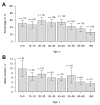Large outbreak of Cryptosporidium hominis infection transmitted through the public water supply, Sweden
- PMID: 24655474
- PMCID: PMC3966397
- DOI: 10.3201/eid2004.121415
Large outbreak of Cryptosporidium hominis infection transmitted through the public water supply, Sweden
Abstract
In November 2010, ≈27,000 (≈45%) inhabitants of Östersund, Sweden, were affected by a waterborne outbreak of cryptosporidiosis. The outbreak was characterized by a rapid onset and high attack rate, especially among young and middle-aged persons. Young age, number of infected family members, amount of water consumed daily, and gluten intolerance were identified as risk factors for acquiring cryptosporidiosis. Also, chronic intestinal disease and young age were significantly associated with prolonged diarrhea. Identification of Cryptosporidium hominis subtype IbA10G2 in human and environmental samples and consistently low numbers of oocysts in drinking water confirmed insufficient reduction of parasites by the municipal water treatment plant. The current outbreak shows that use of inadequate microbial barriers at water treatment plants can have serious consequences for public health. This risk can be minimized by optimizing control of raw water quality and employing multiple barriers that remove or inactivate all groups of pathogens.
Keywords: Cryptosporidium hominis infection; cryptosporidiosis/epidemiology; cryptosporidiosis/prevention and control; cryptosporidiosis/transmission; diarrhea; disease outbreaks; drinking water; molecular typing; questionnaires; risk factors; waste management, parasites; water microbiology; water supply; waterborne infections.
Figures



References
Publication types
MeSH terms
Substances
LinkOut - more resources
Full Text Sources
Other Literature Sources
Medical

